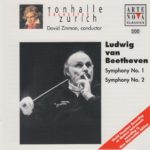 The last time I encountered David Zinman was on (Day 18).
The last time I encountered David Zinman was on (Day 18).
If I recall correctly, I was less than enamored, awarding the performance a resounding “Meh!”
In retrospect, I think that was because of so many firsts: First all-digital (DDD) recording, first time listening to a Urtext Edition, first time listening to a CD from the record label Arte Nova Classics, first time listening to Tonhalle Orchester Zurich , first time listening to David Zinman (1936- ).
Regarding Urtext Editions, here’s a reminder about what they are:
An urtext edition of a work of classical music is a printed version intended to reproduce the original intention of the composer as exactly as possible, without any added or changed material. Other kinds of editions distinct from urtext are facsimile and interpretive editions, discussed below.
So, what Zinman and his orchestra are using in this recording is sheet music that may differ slightly (or, perhaps, greatly) from what was used in previous recordings to which I’ve listened. One of the champions of Urtext Editions is Jonathan Del Mar (1951- ), who wrote some of the liner notes in this Zinman box set.
 Beethoven wrote his symphonies in four parts (except for the Sixth, which is in five). The time breakdown of this particular one (Symphony No. 2 in D Major), from this particular conductor (Zinman, at age 62) and this particular orchestra (Tonhalle Orchster Zurich), at this particular time in history (December 15 & 16, 1998) on this particular record label (Arte Nova Classics – no web site or Wiki entry available) is as follows:
Beethoven wrote his symphonies in four parts (except for the Sixth, which is in five). The time breakdown of this particular one (Symphony No. 2 in D Major), from this particular conductor (Zinman, at age 62) and this particular orchestra (Tonhalle Orchster Zurich), at this particular time in history (December 15 & 16, 1998) on this particular record label (Arte Nova Classics – no web site or Wiki entry available) is as follows:
I. Adagio molto – Allegro con brio………………………………………………………………10:56
II. Larghetto…………………………………………………………………………………………………..9:00
III. Scherezo. Allegro – Trio……………………………………………………………………………3:34
IV. Allegro molto…………………………………………………………………………………………….6:04
Total running time: 29:34
My Rating:
Recording quality: 5 (sounds flawless, if a bit dry; could be the all-digital recording)
Overall musicianship: 4 (supremely competent; yet, not inspired)
CD liner notes: 3 (a booklet in each CD jewel case; however, the information is a hodgepodge that lacks even running times for each track, as well as total running time for each symphony)
How does this make me feel: 4
I liked this recording better than the first time I heard Zinman, Tonhalle Orchester Zurich, and the Urtext Edition of a Beethoven symphony. Maybe I’m used to it by now. Who knows?
This recording is crisp and clear. Can’t fault it on its technical qualities.
As with the last time I heard Zinman (Day 18), I mentioned that it sounded like I was hearing different instruments. Or hearing what was already there in a different/new way.
That’s true this time, too. It’s the brass instruments that sound different to me. A few chime in now and then in a way, or with such unique clarity or tone, that I swear I didn’t hear them in previous performances from other conductors. Maybe I’m just listening harder with these Zinman recordings.
Although this performance of Beethoven’s Second isn’t a “Huzzah!” it’s a notch or two above a “Meh!”
What’s lacking to me is exuberance. The magic. Because of the DDD (all-digital) recording, the Urtext Edition, and the hodgepodge liner notes that seem unfocused, it all seems very technical to me. Very left brain. Proficient…to a fault. But I’m not hearing reckless abandon, unbridled excitement.
Another aspect to consider is the tempo of this piece. Again, it’s one of the shortest of any I’ve heard. Either Maestro Zinman is speeding things up a bit, or the Urtext Edition omits a few bars of music here and there. I don’t know. All I do know is that, at 29:34, this is likely the shortest of any Second I heard.
Maybe I’m just nitpicking.
I dunno. I have another seven symphonies from Zinman to which I will listen before I’m done with my project. These slight but noticeable differences will either become commonplace to me – or they’ll drive me nuts.
Time will tell.
